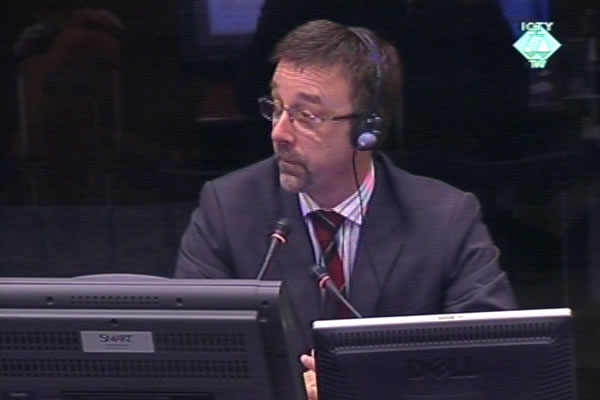Home
UN SOLDIERS USED AS HUMAN SHIELDS
Former military observer from Holland Marcus Helgers described at the trial of Radovan Karadzic how the Serb forces held him and other UN soldiers hostage and used them as human shields to protect the radar facility on Mount Jahorina against NATO air strikes. In his evidence, British general Jonathon Riley spoke about the arrest of 33 of his soldiers during the ‘hostage crisis’ in May and June 1995
 Marcus Helgers, witness at the Radovan Karadzic trial
Marcus Helgers, witness at the Radovan Karadzic trial At the trial of Radovan Karadzic, the prosecution continued calling evidence on the ‘hostage crisis’ in May and June 1995. Two former UN peace-keepers testified today: former military observer from Holland Marcus Helgers, who was captured and used as a human shield by the Serb forces, and British general Jonathon Riley, who commanded the ‘blue helmets’ in Gorazde. Riley’s soldiers were also held hostage by the VRS.
Helgers and five other UN military observers were arrested on 26 May 1995 and taken to Grbavica. There they were forced to put on civilian clothes. ‘I was pretty scared and I was afraid they would take us to the front line where the other side would kill us’, the witness said in his examination-in chief. The witness and the others were taken to Mount Jahorina where they were used as a ‘human shield’ to protect the radar unit against NATO strikes. If NATO aircraft were to target the facility, the Serb soldiers threatened them saying they would all be killed even if they survived the actual strike.
In the course of Helgers’s evidence, the prosecutor showed footage broadcast by the Pale TV. The witness recognized several UN soldiers in the footage; the VRS held them hostage at the same location. One of them is Pole Janusz Kalbarczyk, who is scheduled to testify on Friday. In other videos, the witness was able to identify his fellow countryman who had been chained to an aircraft hangar near Banja Luka by the Serb soldiers. Helgers was held for 20 days on Mount Jahorina and was then transferred to Novi Sad via Zvornik. On 19 June 1995, Helgers was released.
General Riley confirmed that in late May 1995 in the Gorazde enclave the VRS captured 33 soldiers of the First Battalion, Royal Welsh Fusiliers, under his command at the time. The prosecutor brought up documents of the VRS Drina Corps listing possible targets of NATO strikes. The captured UN soldiers were to be put there. According to General Riley, all the sites where his soldiers were held hostage are listed in the document. In General Riley’s view, this kind of treatment of UN peace-keepers was ‘entirely inappropriate and contrary to the Geneva conventions even if they had been prisoners of war and not hostages’. The VRS documents ‘clearly show that everything was ordered and coordinated at the top level’, Riley said.
In his cross-examination of the two witnesses, Karadzic mostly focused on the ‘state of mind’, on what the Serbs ‘could believe’ at the time and not ‘what really happened’. In his cross-examination of Helgers, Karadzic put it to him that the Serb forces had asked the UN members to change into civilian clothes to ‘protect’ them from those who were angry at the UN because of the NATO strikes. As for the arrests, Karadzic tried to justify them by saying the Serb forces suspected NATO of using UN soldiers as artillery spotters. In his cross-examination of General Riley, Karadzic went further and said the Drina Corps commander General Zivanovic, ‘saw UNPROFOR as an ally of NATO and Muslim forces’. The Welsh soldiers were captured in General Zivanovic’s area of responsibility. Riley categorically dismissed any possibility that there had been any such alliance.
The trial of Radovan Karadzic continues on Friday with the evidence of yet another peace-keeper who was held hostage by Mladic’s troops, Janusz Kalbarczyk, from Poland.
Photos
Linked Reports
- Case : Karadzic
- 2011-01-25 KARADZIC AT WAR WITH ‘UN ARMY’
- 2011-01-20 KARADZIC: CIVILIANS WERE NOT KILLED DELIBERATELY
- 2011-01-19 SUFFOCATING SARAJEVO
- 2011-01-28 UNARMED OBSERVERS AS ‘WARRING SIDE’
- 2011-01-31 KARADZIC DEMANDS PRIVACY PROTECTION
- 2011-01-31 KARADZIC CONTESTS VALIDITY OF SARAJEVO INVESTIGATIONS

